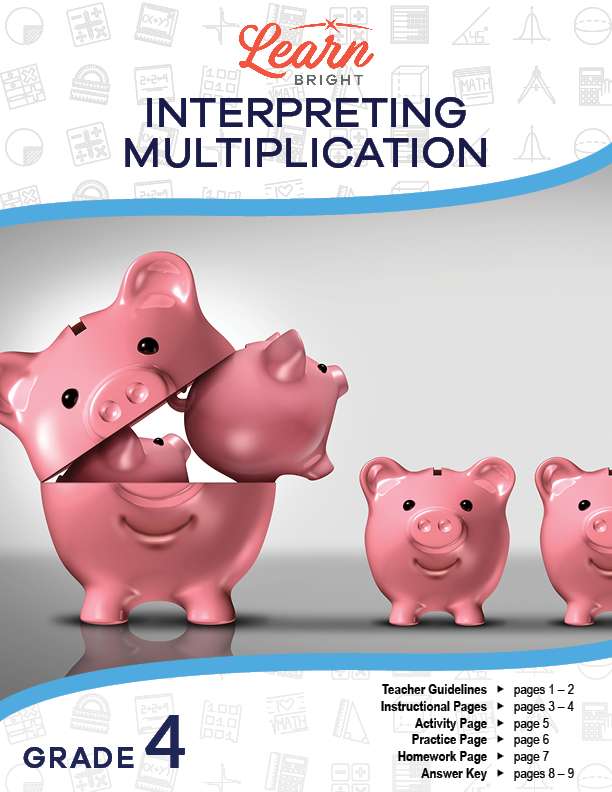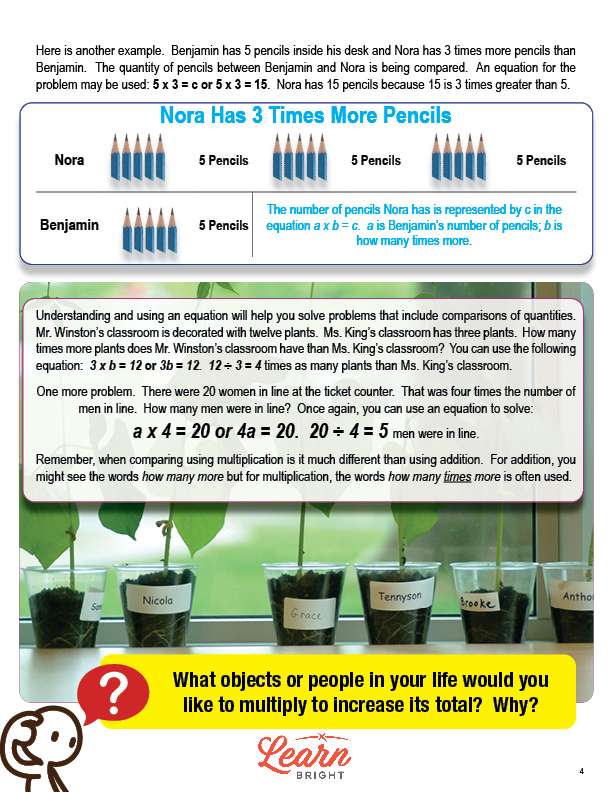Description
What our Interpreting Multiplication lesson plan includes
Lesson Objectives and Overview: Interpreting Multiplication teaches students about multiplication beyond the multiplication facts, including how to conceptualize it and how to compare one problem to another. At the end of the lesson, students will be able to interpret a multiplication equation as a comparison and represent verbal statements of multiplicative comparisons as multiplication equations. This lesson is for students in 4th grade.
Classroom Procedure
Every lesson plan provides you with a classroom procedure page that outlines a step-by-step guide to follow. You do not have to follow the guide exactly. The guide helps you organize the lesson and details when to hand out worksheets. It also lists information in the blue box that you might find useful. You will find the lesson objectives, state standards, and number of class sessions the lesson should take to complete in this area. In addition, it describes the supplies you will need as well as what and how you need to prepare beforehand. The only supplies you will need for this lesson are the handouts. To prepare for this lesson ahead of time, you can copy the handouts and pair students for the activity.
Options for Lesson
Included with this lesson is an “Options for Lesson” section that lists a number of suggestions for activities to add to the lesson or substitutions for the ones already in the lesson. One optional addition to this lesson is to increase the number of word problems in the activity. You can also have students create their own word problems based on items in the classroom. If your students need help interpreting the multiplication in this lesson, you can distribute manipulatives for them to use. Finally, you can use the homework assignment as a quiz if you’d like.
Teacher Notes
The teacher notes page includes a paragraph with additional guidelines and things to think about as you begin to plan your lesson. This page also includes lines that you can use to add your own notes as you’re preparing for this lesson.
INTERPRETING MULTIPLICATION LESSON PLAN CONTENT PAGES
Interpreting Multiplication
The Interpreting Multiplication lesson plan includes two pages of content. The lesson begins by reminding students that they already know multiplication facts from 0 x 0 to 12 x 12. 0 x 0 = 0 and 12 x 12 = 144. Students might have memorized these facts. They might have used pictures or repeated addition to help them learn to multiply two or more numbers together. The lesson includes a picture that has three rows of four stars. These three groups of four stars has a product of 12 stars. We can write this problem as 3 x 4 = 12, or can use repeated addition with the problem 4 + 4 + 4 = 12.
We can also use multiplication to compare quantities. If you have a bag of candy that has 6 pieces in it, and a friend has a bag with 3 times as many, you can compare the quantities in each bag. In this example, you can compare your 6 pieces with your friend’s 18 pieces (because 6 x 3 = 18). Your friend has more!
The lesson then delves into another example using pencils. One person has 5 pencils, and their friend has 3 times more. When comparing the number of pencils, we can tell that the friend has more because 5 is less than 15 (3 x 5 = 15). We can represent this as the equation a x b = c, with a being the first person’s pencils and b being how many times more pencils the second person has.
If you understand and use these kinds of equations, you will become better at solving problems that include the comparison of quantities. The lesson closes with two final example problems. The last example states that there are 20 women in line, which was 4 times the number of men in line. It asks how many men were in line. To solve, we can use an equation: a x 4 = 20 or 4a = 20. 20 / 4 = 5, so 5 men were in line.
Comparing using multiplication is different than using addition. When using addition, we might see the phrase how many more, but with multiplication, we’re more likely to see the phrase how many times more.
INTERPRETING MULTIPLICATION LESSON PLAN WORKSHEETS
The Interpreting Multiplication lesson plan includes three worksheets: an activity worksheet, a practice worksheet, and a homework assignment. You can refer to the guide on the classroom procedure page to determine when to hand out each worksheet.
WORD PROBLEMS ACTIVITY WORKSHEET
Students will work with a partner to complete this activity worksheet. Each pair will create five challenging word problems that can be solved using multiplicative comparison by another pair of students. They will also create an answer key for their problems.
Students may work either alone or in groups for this activity if you’d prefer.
SOLVING PROBLEMS PRACTICE WORKSHEET
The practice worksheet asks students to complete three short exercises. For the first, they will read five statements and determine whether they are true or false. For the second, they will fill in each set of blanks. Finally, for the third, they will circle the correct answer(s) for four problems.
INTERPRETING MULTIPLICATION HOMEWORK ASSIGNMENT
The homework assignment asks students to write an equation to solve eight word problems.
Worksheet Answer Keys
This lesson plan includes answer keys for the practice worksheet and the homework assignment. If you choose to administer the lesson pages to your students via PDF, you will need to save a new file that omits these pages. Otherwise, you can simply print out the applicable pages and keep these as reference for yourself when grading assignments.









